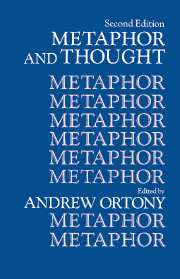Book contents
- Frontmatter
- Contents
- List of contributors
- Preface to the second edition
- Preface to the first edition
- 1 Metaphor, language, and thought
- METAPHOR AND MEANING
- METAPHOR AND REPRESENTATION
- METAPHOR AND UNDERSTANDING
- METAPHOR AND SCIENCE
- METAPHOR AND EDUCATION
- 24 The instructive metaphor: Metaphoric aids to students' understanding of science
- 25 Metaphor and learning
- 26 Learning without metaphor
- 27 Educational uses of metaphor
- References
- Author index
- Subject index
27 - Educational uses of metaphor
Published online by Cambridge University Press: 05 June 2012
- Frontmatter
- Contents
- List of contributors
- Preface to the second edition
- Preface to the first edition
- 1 Metaphor, language, and thought
- METAPHOR AND MEANING
- METAPHOR AND REPRESENTATION
- METAPHOR AND UNDERSTANDING
- METAPHOR AND SCIENCE
- METAPHOR AND EDUCATION
- 24 The instructive metaphor: Metaphoric aids to students' understanding of science
- 25 Metaphor and learning
- 26 Learning without metaphor
- 27 Educational uses of metaphor
- References
- Author index
- Subject index
Summary
As educators, the goal of our inquiries into the nature of cognitive processes is to achieve an understanding of these processes that can be put to use in improving students' learning through improved educational practice. In Petrie and Oshlag's presentation the inquiry focuses on the improvement of educational practice by the more effective use of metaphor. Petrie and Oshlag discuss three topics: (1) the nature of metaphor (as “speech act” rather than “linguistic entity”); (2) the manner in which the metaphor “works” (by creating a cognitive anomaly in the listener); and (3) a prescription for the teacher's use of metaphor (first create an anomaly; next offer opportunity for the student to actively discuss or otherwise become active with the new ideas addressed by the metaphor; and then provide corrective feedback, with several iterations if necessary, to get the student to understand the relationships between the knowledge domains addressed in the metaphor).
In this chapter, I shall follow Petrie and Oshlag's lead and comment on the nature and mechanism of action of metaphorical speech acts. I will make my comments within the context of a discussion of metaphor as a tool for communication and thought. Evidence will be presented to suggest that children and marginally literate adults who lack skills in analytical thinking can be taught aspects of these skills in relatively brief training periods, and that such training can improve their ability to produce and comprehend metaphors.
- Type
- Chapter
- Information
- Metaphor and Thought , pp. 621 - 632Publisher: Cambridge University PressPrint publication year: 1993
- 22
- Cited by



